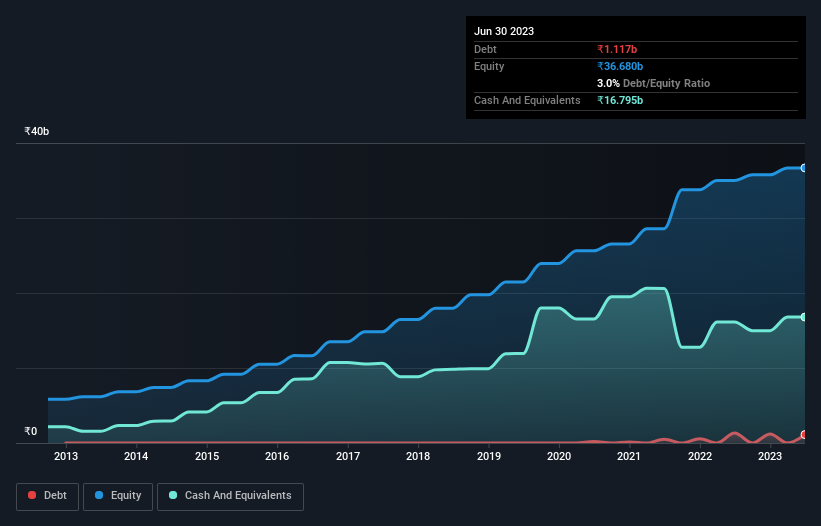- India
- /
- Consumer Durables
- /
- NSEI:WHIRLPOOL
Does Whirlpool of India (NSE:WHIRLPOOL) Have A Healthy Balance Sheet?

Legendary fund manager Li Lu (who Charlie Munger backed) once said, 'The biggest investment risk is not the volatility of prices, but whether you will suffer a permanent loss of capital.' It's only natural to consider a company's balance sheet when you examine how risky it is, since debt is often involved when a business collapses. Importantly, Whirlpool of India Limited (NSE:WHIRLPOOL) does carry debt. But should shareholders be worried about its use of debt?
When Is Debt A Problem?
Debt and other liabilities become risky for a business when it cannot easily fulfill those obligations, either with free cash flow or by raising capital at an attractive price. In the worst case scenario, a company can go bankrupt if it cannot pay its creditors. However, a more common (but still painful) scenario is that it has to raise new equity capital at a low price, thus permanently diluting shareholders. By replacing dilution, though, debt can be an extremely good tool for businesses that need capital to invest in growth at high rates of return. The first step when considering a company's debt levels is to consider its cash and debt together.
Check out our latest analysis for Whirlpool of India
What Is Whirlpool of India's Debt?
As you can see below, Whirlpool of India had ₹1.12b of debt at March 2023, down from ₹1.34b a year prior. But on the other hand it also has ₹16.8b in cash, leading to a ₹15.7b net cash position.

How Strong Is Whirlpool of India's Balance Sheet?
The latest balance sheet data shows that Whirlpool of India had liabilities of ₹19.0b due within a year, and liabilities of ₹3.93b falling due after that. On the other hand, it had cash of ₹16.8b and ₹4.98b worth of receivables due within a year. So it has liabilities totalling ₹1.13b more than its cash and near-term receivables, combined.
Having regard to Whirlpool of India's size, it seems that its liquid assets are well balanced with its total liabilities. So it's very unlikely that the ₹190.4b company is short on cash, but still worth keeping an eye on the balance sheet. While it does have liabilities worth noting, Whirlpool of India also has more cash than debt, so we're pretty confident it can manage its debt safely.
In fact Whirlpool of India's saving grace is its low debt levels, because its EBIT has tanked 44% in the last twelve months. When a company sees its earnings tank, it can sometimes find its relationships with its lenders turn sour. There's no doubt that we learn most about debt from the balance sheet. But ultimately the future profitability of the business will decide if Whirlpool of India can strengthen its balance sheet over time. So if you want to see what the professionals think, you might find this free report on analyst profit forecasts to be interesting.
Finally, a company can only pay off debt with cold hard cash, not accounting profits. Whirlpool of India may have net cash on the balance sheet, but it is still interesting to look at how well the business converts its earnings before interest and tax (EBIT) to free cash flow, because that will influence both its need for, and its capacity to manage debt. In the last three years, Whirlpool of India's free cash flow amounted to 23% of its EBIT, less than we'd expect. That's not great, when it comes to paying down debt.
Summing Up
While it is always sensible to look at a company's total liabilities, it is very reassuring that Whirlpool of India has ₹15.7b in net cash. So we are not troubled with Whirlpool of India's debt use. The balance sheet is clearly the area to focus on when you are analysing debt. But ultimately, every company can contain risks that exist outside of the balance sheet. These risks can be hard to spot. Every company has them, and we've spotted 1 warning sign for Whirlpool of India you should know about.
Of course, if you're the type of investor who prefers buying stocks without the burden of debt, then don't hesitate to discover our exclusive list of net cash growth stocks, today.
Valuation is complex, but we're here to simplify it.
Discover if Whirlpool of India might be undervalued or overvalued with our detailed analysis, featuring fair value estimates, potential risks, dividends, insider trades, and its financial condition.
Access Free AnalysisHave feedback on this article? Concerned about the content? Get in touch with us directly. Alternatively, email editorial-team (at) simplywallst.com.
This article by Simply Wall St is general in nature. We provide commentary based on historical data and analyst forecasts only using an unbiased methodology and our articles are not intended to be financial advice. It does not constitute a recommendation to buy or sell any stock, and does not take account of your objectives, or your financial situation. We aim to bring you long-term focused analysis driven by fundamental data. Note that our analysis may not factor in the latest price-sensitive company announcements or qualitative material. Simply Wall St has no position in any stocks mentioned.
About NSEI:WHIRLPOOL
Whirlpool of India
Manufactures and markets home appliances in India and internationally.
Excellent balance sheet with reasonable growth potential.
Market Insights
Community Narratives




